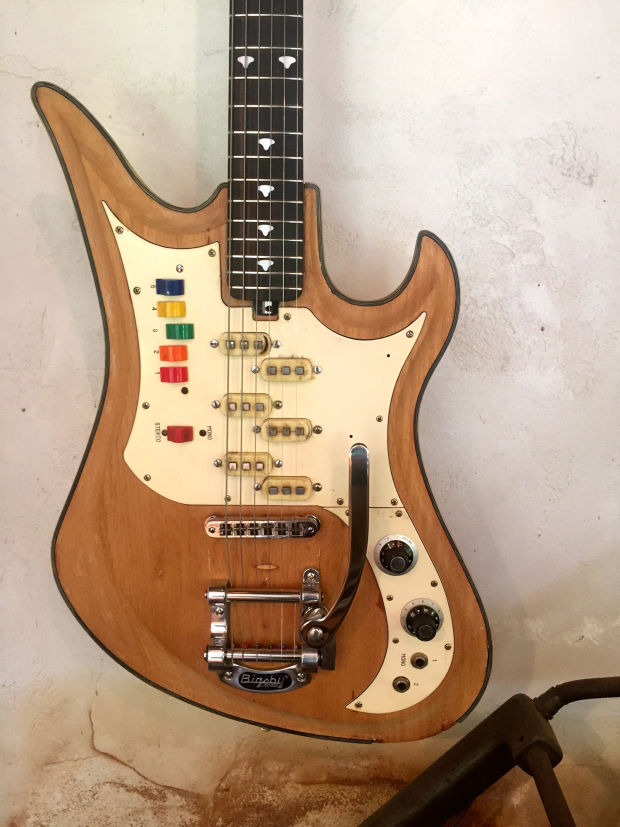
Unlike my first-ever sighting of a Wandré Rock Oval guitar, I can’t remember where I first became aware of the 1966 Teisco Spectrum 5. I do recall that I noticed a blue one in Les Blank’s film of Ry Cooder’s Moula Banda Rhythm Aces, recorded at the Catalyst in Santa Cruz. That guitar had its primary-color switch leitmotif swapped for something apparently more useful, but it was a Spectrum 5 nonetheless. Sleepy LaBeef is reported to have played one as well.
What catapulted this remarkable stereo guitar to broader awareness was either Eddie Van Halen’s use of it in the 1988 monochrome video for the OU812 track “Finish What Ya Started” or Larry DiMarzio’s photo of Eddie cradling that same red Spectrum 5 on the February 1990 cover of Guitar World magazine. It was around that time that a Teisco Spectrum 5 showed up on a table at the Philadelphia Guitar Show with a card stuck between the strings that read: “Be Cool Like Eddie: $1,000.”
A few tables downwind, I noticed a dilapidated Spectrum 5 guitar suffering from a host of ailments. Aside from remarkable wear on the fingerboard and plastic pickup covers, it was missing half of its tailpiece—the oddball unit appeared to be a cocktail of Doc Kauffman’s Vibrola and a Burns vibrato. But what really puzzled me was the red polyester finish that had a most unusual densely crackled patina. It was the kind of thing you’d expect to see on a plywood archtop guitar, like an early Fifties Gibson ES-5, but not on a Japanese relic lovingly frosted in bulletproof polyester. I considered making a purchase while ambling among the myriad distractions, but upon my return the guitar was gone.
Two years later, I fielded a call from my guitar scout saying he had picked up a Spectrum 5 for me, which turned out to be a Macy’s shopping bag containing a completely disassembled guitar. Both the neck and body were inexplicably stripped and slathered in gray car spackle. I began a slow, almost meditative process of sanding off the Bondo, usually while on the phone. I don’t know why I persisted with this laborious process, since a lot of the parts were missing and the serpentine electrical wiring appeared to have been attacked by a skunk looking for grubs. Moreover, I had no idea what the electronics were supposed to do. I sent the pickguard with its six pickup coils and the rat’s nest wiring to my longtime savior Mike Koontz in Ferndale, Michigan, with a note that said “Help.”
Imagine my surprise when, after several months of careful sanding, I came across a fleck of the original finish—a remarkably crackled dark red paint that I instantaneously reconnected to the guitar I missed at the Philly show. Somehow that hacked-up gakki found its way back to me. It was around this time that I noticed the ebony fingerboard was as badly worn as any maple fingerboard I’d ever seen, which probably meant that at one point this had been a good guitar that had received heavy use.
I repaired the damaged Philippine mahogany body, reattached the neck, and let it sit in my shop while I got on with doing things that paid the bills. A few years later, the revitalized pickguard returned with a note that said that the two mysterious choke coils in the circuit were most likely to indicate some sort of a low-impedance circuit design. Plug straight into the recording console? Surely they were jesting.
I never liked the combined bridge-and-tailpiece design of these guitars. Already hampered by the very low-angled headstock, the strings transferred a fairly low amount of physical energy onto the six metal saddles, giving the guitar a very quiet voice. Being in the very unique circumstance of having a completely knackered and plundered Spectrum 5 gave me the only excuse possible to replace the original tailpiece arrangement with an anchored Tune-o-matic bridge and a Bigsby B5 vibrato tailpiece, whose front roller gives the strings the downward pressure on the bridge they needed to awaken our sleeping samurai.
After replacing the original shagged paperclips with some usable frets, a dramatic increase in sustain was audible without plugging the guitar in. This particular neck is an unusually thin three-piece maple composite crowned with a streaked ebony fingerboard with inlays that recall Roger Dean’s “Floating Planet.” The guitar sounds so good that I can’t bear the thought of taking it apart to repaint it.
I recommend using two cords to connect the Spectrum 5 to two separate amps with the stereo switch engaged. Somehow it does sound better than going mono, especially playing anything by Sonny Bono, Yoko Ono, or Perry Como.

